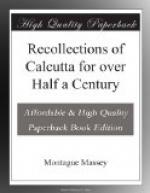THE CURRENCY OFFICE.
The site of this was once occupied by a concern called the Calcutta Auction Company, started, I believe, in competition with the well-known and old-established firm of Mackenzie Lyall & Co. It was a huge barn of a place stretching away from Dalhousie Square to Mission Row, filled from one end to the other with a medley of all sorts of goods and chattels which had been sent in for sale from time to time by various people. The office accommodation was also of the most primitive order, and consisted merely of a slightly raised wooden platform on which were perched a couple of desks and a few chairs. They had never held at any period a position of standing or importance in the commercial world, and some time after my arrival there were unpleasant rumours floating abroad about them, and I recollect shortly before their final collapse the manager’s chair was occupied by the founder of one of the most influential and leading firms of the present day. When it disappeared the ground was acquired by the Agra Bank which erected the present very handsome buildings, shortly after, as far as I remember, it amalgamated with the Masterman Banking Concern in London, and it was subsequently known as Agra and Mastermans Bank.
[Illustration: Photo. by B. & S. Currency Office, built on the site of the old Calcutta Auction Company.]
[Illustration: Photo. by J. & H. Hamilton & Co’s premises, Old Court House Street.]
[Illustration: Photo. by Bourne & Shepherd. Old view of Clive Street.]
[Illustration: Photo. by B. & S. Present view of Clive Street, showing Chartered Bank’s premises on the right, middle centre.]
The office formerly was where Gladstone Wyllie & Co. are now. The amalgamation, I think, did not prove so successful as was anticipated, and eventually Mastermans dropped out of the concern and the bank assumed its old title, and though it was in a sound enough position even up to the date of its liquidation, the management considered it prudent to draw in its horns a little and sold to Government for the office of the currency department the larger part facing Dalhousie Square. It then retired to the back part of the premises looking on to Mission Row, which became the entrance to the bank. As time went on the bank seemed in some way or another to dwindle in standing and importance, and it did not tend to increase either its reputation




